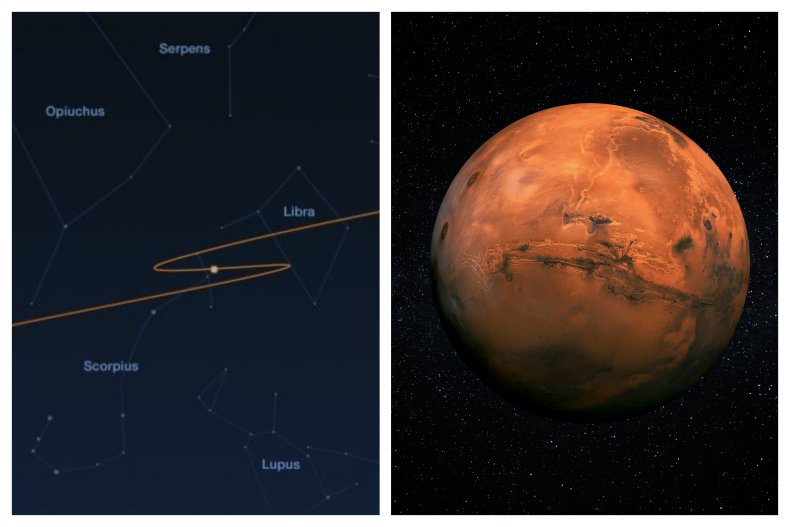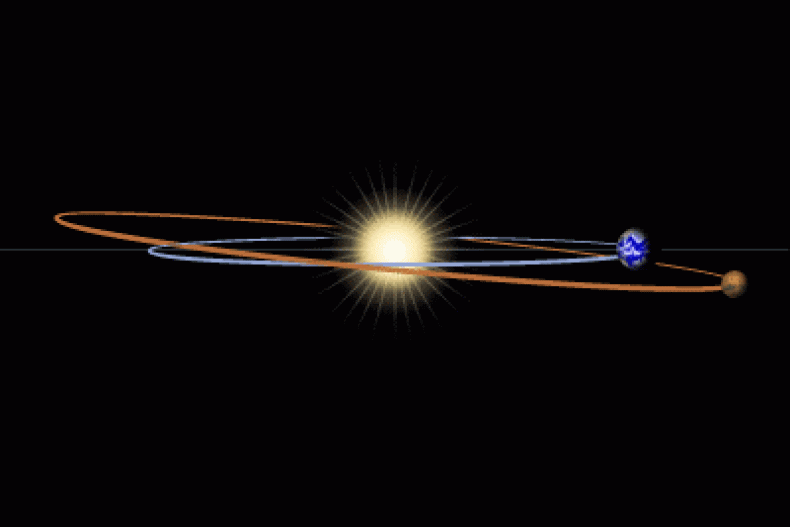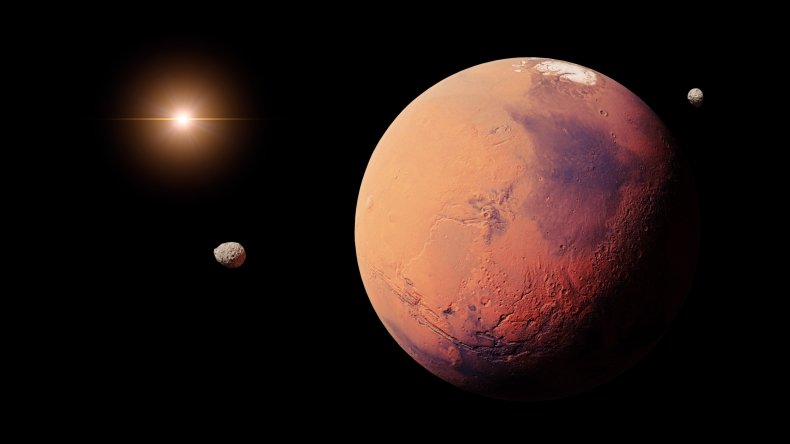BY JESS THOMSON
ON 11/1/22 AT
What Happens When Mars Is In Retrograde?
Mars has just entered retrograde, suddenly reversing its course across the sky.
As of October 30, Mars stopped moving eastwards through the night sky and began crawling its way westwards through the constellation of Taurus. It will continue to move this direction until January 23, 2023, before reversing course once again and traveling towards the east.
Despite how it may look from Earth, Mars is not actually changing course at all, rather the relative positions of Earth and Mars in their orbits around the sun have led to this strange dance in the night sky.

What Happens When Mars Is In Retrograde?
Mars has just entered retrograde, suddenly reversing its course across the sky.
As of October 30, Mars stopped moving eastwards through the night sky and began crawling its way westwards through the constellation of Taurus. It will continue to move this direction until January 23, 2023, before reversing course once again and traveling towards the east.
Despite how it may look from Earth, Mars is not actually changing course at all, rather the relative positions of Earth and Mars in their orbits around the sun have led to this strange dance in the night sky.

Stock image of Mars (right) and an illustration of the view of Mars'
retrograde motion in 2016 as seen from NASA Mission Control in Pasadena,
Mars is our second-closest planetary neighbor, and orbits the sun once every 1.88 Earth years, or 687 days.
"The motion of the planets against the background stars, as we see it from Earth, is caused by the actual motion of those planets, but also by the motion of the Earth, since we're on it. It is therefore an effect of geometry of the planet orbits," Rok Nežič, an astronomer at the Armagh Observatory & Planetarium in Northern Ireland, told Newsweek.
According to Nežič, all the planets move around the sun in the counterclockwise direction, assuming a viewpoint from above the Earth's north pole, so they generally seem to move eastwards relative to the stars.
"Kepler's Laws of Motion tell us the planets closer to the sun move faster than the planets farther away. This is because the gravity of the sun gets weaker if you are further away," Nežič said.
"This means the Earth occasionally 'overtakes' the outer planets on its journey around the sun. As it does that, the position of Mars in this case, appears to stop against the background stars, then it starts moving westward relative to the background stars. Both planets are still moving counter-clockwise around the sun, but because Mars is slower and being overtaken by the Earth, it seems to move the other way against a distant background."
When the planets move further apart again, the "normal" apparent motion across the sky resumes, and Mars begins to move in its usual direction.
As the Earth overtakes Mars, we will approach our closest point to the Red Planet: on December 1, we will be a mere 0.545 astronomical units [51 million miles] apart, according to spaceweather.com. At our furthest point away from Mars, when Earth and Mars are on opposite sides of the sun, we are around 250 million miles away from the planet.

"What matters much more is when Mars and Earth are in solar conjunction, which means they're on opposite sides of the sun. That makes communicating with spacecraft much harder, so mission teams have to plan around conjunctions (which happen fairly regularly)," Paul Byrne, a planetary geology professor at North Carolina State University, told Newsweek.
This strange movement was a mystery to early humans, who initially believed that the Earth was the center of the universe.
"The ancient astronomers of Greece could not explain this motion as it did not adhere to their belief of a 'perfection of the Heavens' in which planets moved in perfect circles at constant speed as they orbited the Earth," Vahé Peroomian, a physicist at the University of Southern California, told Newsweek.
"They had to invent various devices, including circles upon circles they called 'epicycles' to account for this motion. Nicolas Copernicus was the first to correctly explain apparent retrograde motion. In his model of the Solar System, in which he placed the sun, and not the Earth, at the center, planets closer to the sun moved faster than planets farther out, catching up to and passing them."
Mars is our second-closest planetary neighbor, and orbits the sun once every 1.88 Earth years, or 687 days.
"The motion of the planets against the background stars, as we see it from Earth, is caused by the actual motion of those planets, but also by the motion of the Earth, since we're on it. It is therefore an effect of geometry of the planet orbits," Rok Nežič, an astronomer at the Armagh Observatory & Planetarium in Northern Ireland, told Newsweek.
According to Nežič, all the planets move around the sun in the counterclockwise direction, assuming a viewpoint from above the Earth's north pole, so they generally seem to move eastwards relative to the stars.
"Kepler's Laws of Motion tell us the planets closer to the sun move faster than the planets farther away. This is because the gravity of the sun gets weaker if you are further away," Nežič said.
"This means the Earth occasionally 'overtakes' the outer planets on its journey around the sun. As it does that, the position of Mars in this case, appears to stop against the background stars, then it starts moving westward relative to the background stars. Both planets are still moving counter-clockwise around the sun, but because Mars is slower and being overtaken by the Earth, it seems to move the other way against a distant background."
When the planets move further apart again, the "normal" apparent motion across the sky resumes, and Mars begins to move in its usual direction.
As the Earth overtakes Mars, we will approach our closest point to the Red Planet: on December 1, we will be a mere 0.545 astronomical units [51 million miles] apart, according to spaceweather.com. At our furthest point away from Mars, when Earth and Mars are on opposite sides of the sun, we are around 250 million miles away from the planet.

NASA not-to-scale illustration of Earth and Mars' orbits.
NASA / NASA MARS EXPLORATION PROGRAM
"This happens every two years or so, when Mars is high in the night sky around midnight. This is also when Mars is closest to Earth, and so is a good time to launch a spacecraft to Mars," Jason Wright, a professor of astronomy and astrophysics at Penn State and the director of the Penn State Extraterrestrial Intelligence Center, told Newsweek.
If we are far outside this launch window, the amount of fuel required to get a spacecraft to Mars will be a lot higher and therefore the launch will be much more expensive.
Additionally, the further apart the two planets are, the greater the delay in communications: light takes between five and 20 minutes to travel between Earth and Mars, depending on the distance.

"This happens every two years or so, when Mars is high in the night sky around midnight. This is also when Mars is closest to Earth, and so is a good time to launch a spacecraft to Mars," Jason Wright, a professor of astronomy and astrophysics at Penn State and the director of the Penn State Extraterrestrial Intelligence Center, told Newsweek.
If we are far outside this launch window, the amount of fuel required to get a spacecraft to Mars will be a lot higher and therefore the launch will be much more expensive.
Additionally, the further apart the two planets are, the greater the delay in communications: light takes between five and 20 minutes to travel between Earth and Mars, depending on the distance.

Mars and it's moons, Phobos and Deimos, named for the Greek gods of fear and panic.
"What matters much more is when Mars and Earth are in solar conjunction, which means they're on opposite sides of the sun. That makes communicating with spacecraft much harder, so mission teams have to plan around conjunctions (which happen fairly regularly)," Paul Byrne, a planetary geology professor at North Carolina State University, told Newsweek.
This strange movement was a mystery to early humans, who initially believed that the Earth was the center of the universe.
"The ancient astronomers of Greece could not explain this motion as it did not adhere to their belief of a 'perfection of the Heavens' in which planets moved in perfect circles at constant speed as they orbited the Earth," Vahé Peroomian, a physicist at the University of Southern California, told Newsweek.
"They had to invent various devices, including circles upon circles they called 'epicycles' to account for this motion. Nicolas Copernicus was the first to correctly explain apparent retrograde motion. In his model of the Solar System, in which he placed the sun, and not the Earth, at the center, planets closer to the sun moved faster than planets farther out, catching up to and passing them."
COPERNICUS WAS ANOTHER CATHOLIC BLASPHEMER DEFENDED BY THE PROTESTANT MAGUS TO QE, AND HIMSELF A MONIST, DR. JOHN DEE.
No comments:
Post a Comment